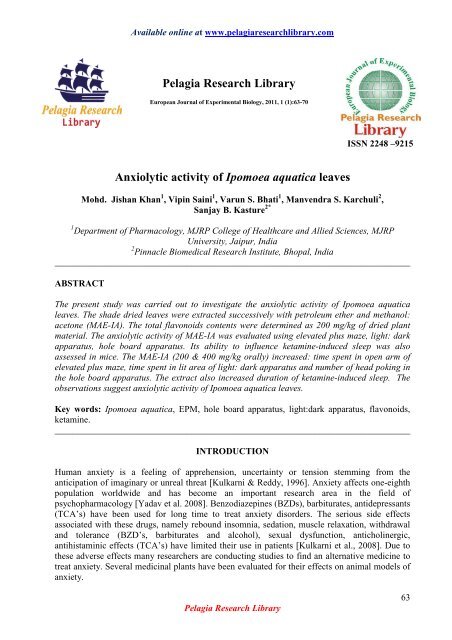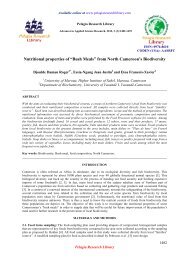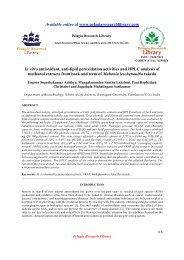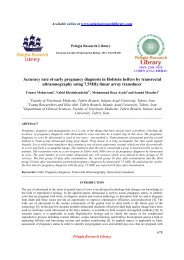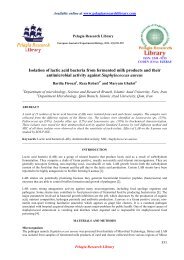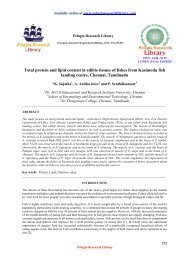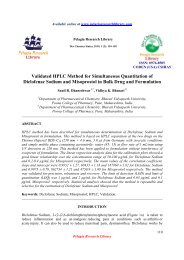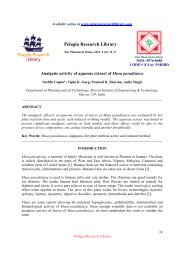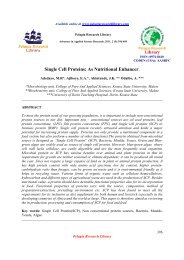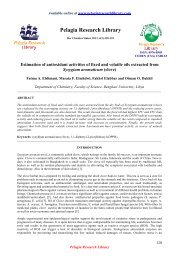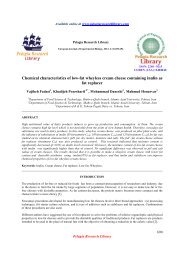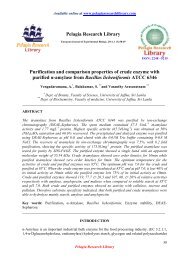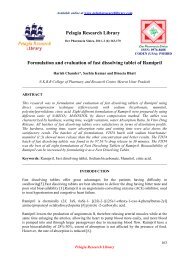Anxiolytic activity of Ipomoea aquatica leaves - Pelagia Research ...
Anxiolytic activity of Ipomoea aquatica leaves - Pelagia Research ...
Anxiolytic activity of Ipomoea aquatica leaves - Pelagia Research ...
Create successful ePaper yourself
Turn your PDF publications into a flip-book with our unique Google optimized e-Paper software.
Available online at www.pelagiaresearchlibrary.com<br />
<strong>Pelagia</strong> <strong>Research</strong> Library<br />
European Journal <strong>of</strong> Experimental Biology, 2011, 1 (1):63-70<br />
ISSN 2248 –9215<br />
<strong>Anxiolytic</strong> <strong>activity</strong> <strong>of</strong> <strong>Ipomoea</strong> <strong>aquatica</strong> <strong>leaves</strong><br />
Mohd. Jishan Khan 1 , Vipin Saini 1 , Varun S. Bhati 1 , Manvendra S. Karchuli 2 ,<br />
Sanjay B. Kasture 2*<br />
1 Department <strong>of</strong> Pharmacology, MJRP College <strong>of</strong> Healthcare and Allied Sciences, MJRP<br />
University, Jaipur, India<br />
2 Pinnacle Biomedical <strong>Research</strong> Institute, Bhopal, India<br />
______________________________________________________________________________<br />
ABSTRACT<br />
The present study was carried out to investigate the anxiolytic <strong>activity</strong> <strong>of</strong> <strong>Ipomoea</strong> <strong>aquatica</strong><br />
<strong>leaves</strong>. The shade dried <strong>leaves</strong> were extracted successively with petroleum ether and methanol:<br />
acetone (MAE-IA). The total flavonoids contents were determined as 200 mg/kg <strong>of</strong> dried plant<br />
material. The anxiolytic <strong>activity</strong> <strong>of</strong> MAE-IA was evaluated using elevated plus maze, light: dark<br />
apparatus, hole board apparatus. Its ability to influence ketamine-induced sleep was also<br />
assessed in mice. The MAE-IA (200 & 400 mg/kg orally) increased: time spent in open arm <strong>of</strong><br />
elevated plus maze, time spent in lit area <strong>of</strong> light: dark apparatus and number <strong>of</strong> head poking in<br />
the hole board apparatus. The extract also increased duration <strong>of</strong> ketamine-induced sleep. The<br />
observations suggest anxiolytic <strong>activity</strong> <strong>of</strong> <strong>Ipomoea</strong> <strong>aquatica</strong> <strong>leaves</strong>.<br />
Key words: <strong>Ipomoea</strong> <strong>aquatica</strong>, EPM, hole board apparatus, light:dark apparatus, flavonoids,<br />
ketamine.<br />
______________________________________________________________________________<br />
INTRODUCTION<br />
Human anxiety is a feeling <strong>of</strong> apprehension, uncertainty or tension stemming from the<br />
anticipation <strong>of</strong> imaginary or unreal threat [Kulkarni & Reddy, 1996]. Anxiety affects one-eighth<br />
population worldwide and has become an important research area in the field <strong>of</strong><br />
psychopharmacology [Yadav et al. 2008]. Benzodiazepines (BZDs), barbiturates, antidepressants<br />
(TCA’s) have been used for long time to treat anxiety disorders. The serious side effects<br />
associated with these drugs, namely rebound insomnia, sedation, muscle relaxation, withdrawal<br />
and tolerance (BZD’s, barbiturates and alcohol), sexual dysfunction, anticholinergic,<br />
antihistaminic effects (TCA’s) have limited their use in patients [Kulkarni et al., 2008]. Due to<br />
these adverse effects many researchers are conducting studies to find an alternative medicine to<br />
treat anxiety. Several medicinal plants have been evaluated for their effects on animal models <strong>of</strong><br />
anxiety.<br />
<strong>Pelagia</strong> <strong>Research</strong> Library<br />
63
Sanjay B. Kasture et al Eur. J. Exp. Bio., 2011, 1 (1): 63-70<br />
______________________________________________________________________________<br />
<strong>Ipomoea</strong> <strong>aquatica</strong> (Forsk), <strong>of</strong> Convolvulaceae family has been originated in China (Edie and Ho,<br />
1969) and distributed throughout India, Sri Lanka, Tropical Asia, Africa, and Australia [Kritkar<br />
and Basu, 1952]. <strong>Ipomoea</strong> <strong>aquatica</strong> have also been used in traditional medicine as a laxative,<br />
recommended for piles, and certain nervous conditions with sleeplessness and head-ache [Burkill<br />
1966; van Valkenburgh & Bunyapraphatsara, 2001], the plant has a calming effect. The juice is<br />
used as an emetic to treat poisoning from opium, arsenic, and from drinking polluted water<br />
[Kapoor & Kapoor 1980; van Valkenburgh & Bunyapraphatsara 2001].<br />
The pre-clinical pharmacological studies indicated moderate anticancer (Prasad et al., 2005),<br />
diuretic [Mamun et al., 2003], oral hypoglycemic [Malalavidhane et al., 2001], anti-ulcer<br />
[Dhanasekaran et al., 2008], CNS depressant, antiepileptic, hypolipidemic effects, anti-microbial<br />
and anti-inflammatory [Dhanasekaran & Palayan, 2010a, b, c], antioxidant and antiproliferative<br />
activities [Omale et al. 2009; Huang et al., 2005] <strong>of</strong> the plant. Miean and Mohamed [2001] have<br />
reported presence <strong>of</strong> flavonoids in the plant and major flavonoid is Quercetin. Flavonoids are<br />
known to have anxiolytic <strong>activity</strong> [Paladini et al., 1999]. Quercetin acts on α 1 β 1 γ 2s GABA A<br />
receptors to produce anxiolysis [Goutman et al., 2003]. They found that mechanism/s underlying<br />
the modulation <strong>of</strong> ionotropic GABA receptors by flavonoids differs from that described for<br />
classic benzodiazepine modulation.<br />
Despite <strong>of</strong> traditional use <strong>of</strong> this plant to aid in sleeping, there is no report on the anxiolytic<br />
<strong>activity</strong> <strong>of</strong> <strong>Ipomoea</strong> <strong>aquatica</strong> <strong>leaves</strong>. We have therefore investigated anxiolytic <strong>activity</strong> <strong>of</strong><br />
flavonoids rich methanol: acetone extract <strong>of</strong> <strong>Ipomoea</strong> <strong>aquatica</strong> using elevated plus maze, light:<br />
dark apparatus, hole board apparatus in mice. Since mixture <strong>of</strong> methanol: acetone effectively<br />
extracts the phenolic compounds, the <strong>leaves</strong> were extracted with methanol: acetone (70:30).<br />
MATERIALS AND METHODS<br />
Drugs and Chemicals: Ketamine, fluoxetine, diazepam, aluminum chloride, sodium-potassium<br />
tartarate, Petroleum ether (40:60), methanol, and acetone and Quercetin were purchased.<br />
Plant material & Extraction<br />
Leaves <strong>of</strong> <strong>Ipomoea</strong> <strong>aquatica</strong> were collected locally from damp region near to various ponds <strong>of</strong><br />
Bhopal. Herbarium <strong>of</strong> plant was prepared and submitted to the Department <strong>of</strong> Botany, Safia<br />
Science College for authentication. Plant was authenticated by Dr. Ziaul Hasan as <strong>Ipomoea</strong><br />
<strong>aquatica</strong> Forsk (Voucher Specimen No. 162/Bot/Safia/10). Leaves were washed and air dried<br />
under shade. The dried <strong>leaves</strong> were powdered and extracted successively with petroleum ether<br />
and a mixture <strong>of</strong> methanol: acetone (70:30) by maceration. The methanol: acetone extract (MAE-<br />
IA) was concentrated under reduced pressure<br />
Animals<br />
Swiss albino mice were obtained from animal house <strong>of</strong> Pinnacle Biomedical <strong>Research</strong> Institute,<br />
Bhopal. All animal experiments were approved by Institutional Animal Ethics Committee<br />
(IAEC) <strong>of</strong> PBRI (Regd. No. 1283/C/09/CPCSEA). All conditions were maintained according to<br />
committee for the purpose <strong>of</strong> Control and Supervision <strong>of</strong> Experiments on Animals (CPCSEA)<br />
norms. The animals <strong>of</strong> either sex were selected randomly <strong>of</strong> uniform weight (25 ± 2 g). The<br />
room temperature was maintained 22±2ºC. Mice had free access to food pellets (Golden feed,<br />
New Delhi) and water. Food and water was withdrawn 6 h before the administrations and during<br />
the experiments.<br />
<strong>Pelagia</strong> <strong>Research</strong> Library<br />
64
Sanjay B. Kasture et al Eur. J. Exp. Bio., 2011, 1 (1): 63-70<br />
______________________________________________________________________________<br />
Phytochemical analysis<br />
The MAE-IA extract was subjected to phytochemical analysis as described by Khandelwal<br />
(1990).<br />
Determination <strong>of</strong> total flavonoids: The aluminum chloride method was used for the<br />
determination <strong>of</strong> the total flavonoid content <strong>of</strong> the sample extracts as described earlier [Merwat<br />
et al., 2009]. Aliquots <strong>of</strong> extract solutions were taken and made up the volume 3ml with<br />
methanol. Then 0.1ml AlCl 3 (10%), 0.1ml Na-K tartarate and 2.8 ml distilled water were added<br />
sequentially. The test solution was vigorously shaken. Absorbance at 415 nm was recorded after<br />
30 minutes <strong>of</strong> incubation. A standard calibration plot was generated at 415 nm using known<br />
concentrations <strong>of</strong> quercetin. The concentrations <strong>of</strong> flavonoid in the test samples were calculated<br />
from the calibration plot and expressed as mg quercetin equivalent /g <strong>of</strong> sample.<br />
Acute toxicity study<br />
The acute oral toxicity study was carried out according to OECD 423 guideline.<br />
ASSESSMENT OF ANXIOLYTIC ACTIVITY<br />
Elevated plus-maze test<br />
The test procedure and scoring methodology for the elevated plus-maze test have been described<br />
by [Pellow et al., 1985]. In brief, the apparatus was composed <strong>of</strong> two open (30 × 5 cm) and two<br />
enclosed (30 × 5 × 15 cm) arms that radiated from a central platform (5 × 5 cm) to form a plus<br />
sign. The maze floor and the closed arms were covered with black adhesive tape. The plus-maze<br />
was elevated to a height <strong>of</strong> 40 cm above floor level by a single central support and four 25-W red<br />
fluorescent lights arranged as a cross at 100 cm above the maze were used as the source <strong>of</strong><br />
illumination. The experiment was conducted during the dark phase <strong>of</strong> the light cycle (7: 00 –19:<br />
00 pm). The mice in groups <strong>of</strong> six were administered with vehicle or MAE-IA extract (200 and<br />
400 mg/kg, p.o. 1 h before test), or diazepam (1 mg/kg, i.p. 30 min before test). The test was<br />
started by placing the mouse on the central platform <strong>of</strong> the maze facing the closed arm. The<br />
number <strong>of</strong> entries into, and the time spent in each <strong>of</strong> the two types <strong>of</strong> arm, were counted during a<br />
5 min test period. A mouse was considered to have entered an arm when all four paws were in<br />
the arm. The apparatus was cleaned thoroughly between trials.<br />
Light/dark test<br />
The apparatus consisted <strong>of</strong> an open-top wooden box with two distinct chambers, namely, a dark<br />
chamber painted black and illuminated with a dim red light, and a bright chamber painted white<br />
and brightly illuminated with a 100 W white light source placed 17 cm above the box. The mice<br />
in groups <strong>of</strong> six received the treatments as described for the elevated plus maze. The test was<br />
started by placing an animal in the center <strong>of</strong> the brightly lit arena. The time spent and number <strong>of</strong><br />
entries into the lit and dark area, latency to first entry in dark area and total number <strong>of</strong> transitions<br />
between lit and dark area was noted for 10 min as described by Une et al., [2001]. The apparatus<br />
was cleaned between the experiments.<br />
The hole-board test<br />
The apparatus consisted <strong>of</strong> a gray wooden box (40 × 40 × 40 cm ) with six equidistant holes 3<br />
cm in diameter in the floor. The mice were treated as described for the elevated plus maze test.<br />
The trial was started by placing an animal in the center <strong>of</strong> the hole-board, and allowed to explore<br />
the apparatus for 10 min. The total number <strong>of</strong> head-dipping and number <strong>of</strong> exploration was<br />
recorded as described by Une et al., [2001]. Before experiment with each animal, apparatus was<br />
cleaned between the tests.<br />
<strong>Pelagia</strong> <strong>Research</strong> Library<br />
65
Sanjay B. Kasture et al Eur. J. Exp. Bio., 2011, 1 (1): 63-70<br />
______________________________________________________________________________<br />
Ketamine-induced sleep<br />
The effect <strong>of</strong> the studied extract on ketamine-induced sleep (loss <strong>of</strong> righting reflex) was<br />
measured as described by Mimura et al., [1990]. The mice were treated as described for the<br />
elevated plus maze test. The mice were injected with ketamine (80 mg/kg, i.p.) and the latency to<br />
sleep and duration <strong>of</strong> sleep was recorded.<br />
Statistical Analysis<br />
The data was expressed as mean ± standard error <strong>of</strong> mean (SEM). Difference in means were<br />
compared using one way analysis <strong>of</strong> variance (ANOVA) followed by Dunnett’s test. P
Sanjay B. Kasture et al Eur. J. Exp. Bio., 2011, 1 (1): 63-70<br />
______________________________________________________________________________<br />
Ketamine-induced loss <strong>of</strong> righting reflex<br />
The MAE-IA extract significantly reduced latecy to sleep and increased duration <strong>of</strong> sleep. The<br />
lower dose <strong>of</strong> extract was more effective than the higher dose. The observations are presented in<br />
Table 3.<br />
Benzodiazepines (BDZs) are the most widely prescribed class <strong>of</strong> psychoactive drugs in current<br />
therapeutic use, despite the important unwanted side-effects that they produce. Searching for<br />
safer BDZ-receptor (BDZ-R) ligands has demonstrated the existence <strong>of</strong> a new family <strong>of</strong> ligands<br />
which have a flavonoid structure [Medina et al., 1997]. Quercetin, the flavonoid present in <strong>leaves</strong><br />
<strong>of</strong> I. <strong>aquatica</strong> [Miean and Mohamed 2001], has various neuropharmacological effects and<br />
regulates a number <strong>of</strong> ligand-gated ion channels including the 3-HT 3A receptor [Goutman et al.,<br />
2003; Lee et al., 2005] and gamma-aminobutyric acid receptor type A [Kambe et al., 2010].<br />
The acute toxicity study indicated that the extract <strong>of</strong> I. <strong>aquatica</strong> (MAE-IA) is safe and no sign <strong>of</strong><br />
toxicity was observed unto 2000 mg/kg dose. The (MAE-IA) extract which contained flavonoids,<br />
increased time spent in the open arm <strong>of</strong> elevated plus maze which clearly indicated its anxiolytic<br />
<strong>activity</strong> [Lister, 1987; Une et al., 2001]. The effect <strong>of</strong> extract on number <strong>of</strong> entries was not<br />
significant. Pellow et al, [1985] have reported that only clinically effective anxiolytic agents<br />
reduced number <strong>of</strong> entries in open arm. Diazepam significantly increased the number <strong>of</strong> entries<br />
in the open arm.<br />
Table 1: Effect on methanol: acetone extract <strong>of</strong> I. <strong>aquatica</strong> on exploratory movements in light: dark<br />
apparatus<br />
Crawley [1985] reviewed parameters <strong>of</strong> exploratory behaviors responsive to anti-anxiety drugs<br />
with respect to their sensitivity and specificity for anxiolytics in mice. Mouse models appear to<br />
rest on a disinhibition <strong>of</strong> natural exploratory tendencies by anxiolytic treatments.<br />
Chlordiazepoxide and diazepam significantly increase exploration <strong>of</strong> a hole-board, <strong>of</strong> a twochambered<br />
light dark apparatus, increase social interaction under high levels <strong>of</strong> illumination.<br />
Pharmacological specificity was established for the hole-board and light dark transition tests,<br />
<strong>Pelagia</strong> <strong>Research</strong> Library<br />
67
Sanjay B. Kasture et al<br />
Eur. J. Exp. Bio., 2011, 1 (1): 63-70<br />
______________________________________________________________________________<br />
showing that non-anxiolytic categories <strong>of</strong> psychoactive drugs did not produce false positives.<br />
Our observations are in congruence with these findings. The mice treated with MAE-IA extract<br />
(200 mg/kg) and diazepam (1 mg/kg) spent more time in lit area whereas MAE-IA extract (400<br />
mg/kg) significantly reduced time spent in lit area. The MAE-IA extract (200 mg/kg) and<br />
diazepam significantly increased the number <strong>of</strong> entries in lit as well as dark area. The higher<br />
dose <strong>of</strong> extract did not increase e the number <strong>of</strong> entries in lit or dark areas. The inverted ‘U’<br />
shaped dose response curve has been reported earlier [Une et al., 2001]. In the hole board<br />
apparatus, a similar observation was noticed. The anxiolytic agents are known to potentiate<br />
<strong>activity</strong> <strong>of</strong> CNS depressants. The MAE-IA extract significantly potentiated ketamine induced<br />
sleep as indicated by reduction in latency to sleep and increased duration <strong>of</strong> sleep. Similar effect<br />
has been observed by Rabbani et al., [2003]. This indicated the possibility <strong>of</strong> interaction <strong>of</strong> I.<br />
<strong>aquatica</strong> with CNS depressants.<br />
Table 2: Effect on methanol: acetone extract <strong>of</strong> I. <strong>aquatica</strong> on head poking and exploratory movements in<br />
hole board apparatus<br />
Values are mean ± SEM <strong>of</strong> 6 observations. F 3,20 = 20.46, P = 0.0001. * P < 0.05 compared to vehicle treated group. (One-Way<br />
ANOVA followed by Newman Keuls test).<br />
Time (Sec) Spent in open arm<br />
100<br />
90<br />
80<br />
70<br />
60<br />
50<br />
40<br />
30<br />
20<br />
10<br />
0<br />
*<br />
Vehicle<br />
MAE-IA extract<br />
200<br />
MAE-IA extract<br />
400<br />
Diazepam 1<br />
Treatment<br />
.<br />
Figure 1: Effect <strong>of</strong> methanol: acetone extract <strong>of</strong> I. <strong>aquatica</strong> on time spent in open arm.<br />
F 3,20 = 67.71, P = 0.0001. * p < 0.05 compared to vehicle treated group (One-way ANOVA followed by Newman<br />
Keuls test).<br />
<strong>Pelagia</strong> <strong>Research</strong> Library<br />
68
Sanjay B. Kasture et al<br />
Eur. J. Exp. Bio., 2011, 1 (1): 63-70<br />
______________________________________________________________________________<br />
7<br />
No. <strong>of</strong> entries (open arm)<br />
6<br />
5<br />
4<br />
3<br />
2<br />
1<br />
0<br />
Vehicle<br />
MAE-IA extract<br />
200<br />
MAE-IA extract<br />
400<br />
Diazepam 1<br />
Treatment<br />
.<br />
Figure 2: Effect <strong>of</strong> methanol: acetone extract <strong>of</strong> I. <strong>aquatica</strong> (MAE-EA) EA) on number <strong>of</strong> entries in open arm.<br />
Data is present as mean± SEM <strong>of</strong> 6 observations. F 3,20 = 2.8, P = 0.066. (One-way ANOVA followed by Newman<br />
Keuls test).<br />
CONCLUSION<br />
Therefore it may be concluded that the methanol: acetone extract <strong>of</strong> <strong>Ipomoea</strong> <strong>aquatica</strong> <strong>leaves</strong> is<br />
rich in flavonoids and possesses anxiolytic principles and further research is warranted to isolate<br />
its active ingredient(s) and to elucidate the mode <strong>of</strong> action.<br />
REFERENCES<br />
[1] H. Burkill, A Dictionary <strong>of</strong> the Economic Products <strong>of</strong> the Malay Peninsula. Ministry <strong>of</strong><br />
Agriculture and Cooperatives, Kuala Lumpur (1966)<br />
[2] J. N. Crawley. Neurosci Behav Rev. 1985, 9, 37.<br />
[3] S. Dhanasekaran. Int. J. Pharma. Biol. Arch. 2010a, 1, 175.<br />
[4] S. Dhanasekaran, M. Palayan,, S.S. Kumar, Res J Pharma Biol Chem Sci. 2010b. 1, 258.<br />
[5] S. Dhanasekaran, M. Palayan, J Pharm Res 2008,1, 7.<br />
[6] S. Dhanasekaran, M. Palayan. Eur J Chem, 2010c 7, 1555.<br />
[7] H.H. Edie, B.W.C. Ho, Econ. Bot. 1969, 23, 32-36.<br />
[8] N.L. Etkin. Edible Medicines: An Ethnopharmacology <strong>of</strong> Food. The University <strong>of</strong> Arizona<br />
Press, Tucson, Arizona. 2006. .<br />
[9] M.N. Ghosh, Toxicity Studies in Fundamental <strong>of</strong> Experimental Pharmacology, Scientific<br />
Book Agency, New Delhi. 1984 pp 153.<br />
[10] J.D. Goutman, M.D. Waxemberg, F. Doñate-Oliver, P.E. Pomata, D.J. Calvo, Eur J<br />
Pharmacol. 2003,461, 79<br />
[11] S. Hoggs, Pharmacol Biochem Behav. 1996, 54, 21.<br />
[12] D.J. Huang, H.J. Chen, C.D. Lin, Y.H. Lin, Academic Sinica, 2005,115.<br />
[13] D. Kambe, M. Kotani, M. Yoshimoto, S. Kaku, S. Chaki, K. Honda. Brain Res. 2010,<br />
1330, 83.<br />
[14] S.L. Kapoor, L.D. Kapoor. Bull Medico-Ethnobot Res 1980, 1, 120-144. 144.<br />
[15] K.R. Khandelwal. Practical Pharmacognosy Techniques and Experiments, 10th Ed. Nirali<br />
Prakashan, Pune. 2003,149.<br />
[16] K.R. Kiritkar, B.D. Basu. Indian Medicinal Plants. Parbani Press, Kolkata. 1952<br />
<strong>Pelagia</strong> <strong>Research</strong> Library<br />
69
Sanjay B. Kasture et al Eur. J. Exp. Bio., 2011, 1 (1): 63-70<br />
______________________________________________________________________________<br />
[17] S.K. Kulkarni, D.S. Reddy, Meth Find Exp Clin Pharmacol, 1996, 18, 219<br />
[18] S.K. Kulkarni, K. Singh, M. Bishnoi, Indian J Expt. Biol, 2008,46, 633.<br />
[19] B.H. Lee, S.M. Jung, J.H. Lee, J.H. Kim, I.S. Yoon, J.H. Lee, S.H. Choi, S.M. Lee, C.G.<br />
Chang, H.C. Kim, Y.S. Han, H.D. Paik, Y. Kim, S.Y. Nah. Int. Mol. Cells, 2005, 20, 69.<br />
[20] R.G. Lister, Psychopharmacology. 1987, 92, 180.<br />
[21] T.S. Malalavidhane, S.M. Wickramasinghe, E.R. Jansz. J Ethnopharmacol, 2000, 72, 293.<br />
[22] T.S. Malalavidhane, S.M. Wickramasinghe, E.R. Jansz. Phytother Res, 2001, 15, 635.<br />
[23] T.S. Malalavidhane, S.M. Wickramasinghe, M.S. Perera, E.R. Jansz, Phytother Res,<br />
2003,17, 1098.<br />
[24] M.M. Mamun, M.M. Billah, M.A. Ashek, M.M. Ahasan, M.J. Hossain, T. Sultana, J Med<br />
Sci 2003, 5, 395.<br />
[25] J.H. Medina, H. Viola, C. Wolfman, M. Marder, C. Wasowski, D. Calvo, A.C. Paladini,<br />
Neurochem Res. 1997, 22, 419.<br />
[26] M. M. Mervat, El, Far, A. Hanan, A Taie. Australian J Basic Applied Sci. 2009, 3, 3609.<br />
[27] K.H. Miean, S. Mohamed. J. Agric. Food Chem 2001, 49 ,3106.<br />
[28] M. Mimura, A. Namiki, R. Kishi, T. Ikeda, K.H. Miya, Psychopharmacology (Berl).1990,<br />
102, 399.<br />
[29] A.C. Paladini, M. Marder, H. Viola, C. Wolfman, C. Wasowski, J.H. Medina. J Pharm<br />
Pharmacol. 1999, 51, 519.<br />
[30] S. Pellow, P. Chopin, S.E. File, M. Briley, J. Neurosci Methods 1985, 14, 149.<br />
[31] N.K. Prasad, R. Chandrashekhar, G. Ashok, P. Vijayan, S.M. Aradhya, G.R. Shivamurthy.<br />
Indian J. Pharmacol, 2005, 37, 397.<br />
[32] M. Rabbani, S.E. Sajjadi, H.R. Zarei. J. Ethnopharmacol. 2003, 89, 271.<br />
[33] H.D. Une, V.P. Sarveiya, S.C. Pal, V.S. Kasture, S.B. Kasture. Pharmacol Biochem Behav.<br />
2001, 69, 439.<br />
[34] J. L. C. H. Van Valkenburg, N. Bunyapraphatsara. Plant Resources in South-East Asia.<br />
Number 12. Backhuys Publishers, Leiden, The Netherlands.2001.<br />
[35] A.V. Yadav, L.A. Kawale, V.S. Nade, Indian J Pharmacol 2008, 40, 32-36.<br />
<strong>Pelagia</strong> <strong>Research</strong> Library<br />
70


